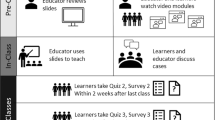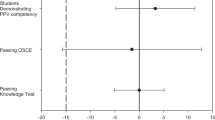Abstract
Objective:
To compare gain in knowledge and skills of neonatal resuscitation using tele-education instruction vs conventional classroom teaching.
Study Design:
This randomized controlled trial was conducted in the tele-education facility of a tertiary care center. In-service staff nurses were randomized to receive training by tele-education instruction (TI, n=26) or classroom teaching (CT, n=22) method from two neonatology instructors using a standardized teaching module on neonatal resuscitation. Gain in knowledge and skill scores of neonatal resuscitation were measured using objective assessment methods.
Result:
Age, educational qualification and professional experience of the participants in two groups were comparable. Pre-training mean knowledge scores were higher in TI group (8.3±1.7 vs 6.6±1.4, P=0.004). However, skill scores were comparable in the two groups (11.7±3 vs 10.3±2.9, P=0.13). Training resulted in a significant and comparable gain in knowledge scores (4.2±2.2 vs 5.3±1.7; P=0.06) and skills scores (4.5±3.3 vs 5.0±3.1, P=0.62) in both the groups. The post-training knowledge scores (TI: 12.5±1.7 vs CT: 12.0±1.7, P=0.37) and the post-training skill scores (TI: 16.0±0.5 vs CT: 15.6±2.5, P=0.55) were comparable in the two groups. However, the post-training scores, adjusted for baseline knowledge scores, were statistically higher in the in-person group compared with the telemedicine group (knowledge: 12.46±0.03 vs 12.16±0.01, P=0.00; skills: 15.6±2.5 vs 16.0±2.8, P=0.00). The quantum of lower scores in the telemedicine group was only 2% for knowledge and 6% for skills. This difference was felt to be of only marginal importance. Satisfaction scores among trainees and instructors were comparable in the two groups.
Conclusion:
Tele-education offers a feasible and effective alternative to conventional training in neonatal resuscitation among health-care providers.
This is a preview of subscription content, access via your institution
Access options
Subscribe to this journal
Receive 12 print issues and online access
$259.00 per year
only $21.58 per issue
Buy this article
- Purchase on Springer Link
- Instant access to full article PDF
Prices may be subject to local taxes which are calculated during checkout



Similar content being viewed by others
References
UNICEF. State of the World's Children's Report. Oxford University Press: New York, 2004.
Paul VK . Newborn care in India: a promising beginning but a long way to go. Semin Neonatol 1999; 4: 141–149.
National Neonatal Perinatal Database Network. National Neonatology Forum of India: Report 2002–2003. National Neonatal Perinatal Database Network: New Delhi, 2004.
Deorari AK, Singh M, Paul VK, Vidyasagar D . Impact of neonatal training programme (NRP) on resuscitation practices in teaching hospitals in India. Pediatr Res 1999; 45: 77.
Kattwinkel J, Bloom RS . Textbook of Neonatal Resuscitation. 5th edn. American Heart Association and Elk Grove Village, III. American Academy of Pediatrics: Dallas, 2006.
Brennan JA, Kealy JA, Gerardi LH, Shih R, Allegra J, Sannipoli L et al. Telemedicine in the emergency department: a randomized controlled trial. J Telemed Telecare 1999; 5: 18–22.
Goh KYC, Lam CK, Poon WS . The impact of teleradiology on the inter-hospital transfer of neurosurgical patients. Br J Neurosurg 1997; 11: 52–56.
Friedman RH, Kazis LE, Jette A, Smith MB, Stollerman J, Torgerson J et al. A telecommunications system for monitoring and counseling patients with hypertension. Impact on medication adherence and blood pressure control. Am J Hypertens 1996; 9: 285–292.
Wu J, Kessler DK, Chakko S, Kessler KM . A cost-effectiveness strategy for transtelephonic arrhythmia monitoring. Am J Cardiol 1995; 75: 184–185.
Trott P, Blignault I . Cost evaluation of a telepsychiatry service in northern Queensland. J Telemed Telecare 1998; 4: 66–68.
Loane MA, Corbett R, Bloomer SE, Eedy DJ, Gore HE, Mathews C et al. Diagnostic accuracy and clinical management by realtime teledermatology. Results from the Northern Ireland arms of the UK Multicentre Teledermatology Trial. J Telemed Telecare 1998; 4: 95–100.
Blackwell NAM, Kelly GJ, Lenton LM . Telemedicine ophthalmology consultation in remote Queensland. Med J Aust 1997; 167: 583–586.
Agha Z, Weinstein RS, Dunn BE . Cost minimization analysis of telepathology. Am J Clin Pathol 1999; 112: 470–478.
Lowen L, Seshia MM, Fraser Askin D, CTonin C, Roberts S . Effective delivery of neonatal stabilization education using videoconferencing in Manitoba. J Telemed Telecare 2003; 9: 334–338.
Cronin C, Cheang S, Hlynka D, Adair E, Roberts S . Videoconferencing can be used to assess neonatal resuscitation skills. Med Educ 2001; 35: 1013–1023.
Ricci MA, Caputo MP, Callas PW . Use of telemedicine for delivering CME in rural community. Telemed J E Health 2005; 11: 124–129.
Bertsch TF, Callas P, Rubin A, Caputo MP, Ricci MA . Effectiveness of lectures attended via interactive video conferencing versus in person in preparing third year internal medicine clerkship students for clinical practice examinations (CPX). Teach Learn Med 2007; 19: 4–8.
Acknowledgements
We acknowledge the contributions made by faculty of Department of Telemedicine and Center of Medical Education and Technology for assistance in conducting the telemedicine sessions, and resident doctors and nurses of Department of Pediatrics for assisting in clinical demonstrations.
Author information
Authors and Affiliations
Corresponding author
Ethics declarations
Competing interests
The authors declare no conflict of interest.
Rights and permissions
About this article
Cite this article
Jain, A., Agarwal, R., Chawla, D. et al. Tele-education vs classroom training of neonatal resuscitation: a randomized trial. J Perinatol 30, 773–779 (2010). https://doi.org/10.1038/jp.2010.42
Received:
Revised:
Accepted:
Published:
Issue Date:
DOI: https://doi.org/10.1038/jp.2010.42
Keywords
This article is cited by
-
Simulation Based vs Conventional Training for Initial Steps in Delivery Room Care of Preterm Neonates: An Open Label Randomized Trial
Indian Pediatrics (2022)
-
Telehealth for Pediatric Cardiology Practitioners in the Time of COVID-19
Pediatric Cardiology (2020)
-
Implementation science in resource-poor countries and communities
Implementation Science (2018)
-
Comparison of Training via Short Messages and Group Training on Level of Knowledge and Practice of Middle-Aged Women About Breast Cancer Screening Tests
Journal of Cancer Education (2018)
-
Addressing health disparities in rural communities using telehealth
Pediatric Research (2016)



